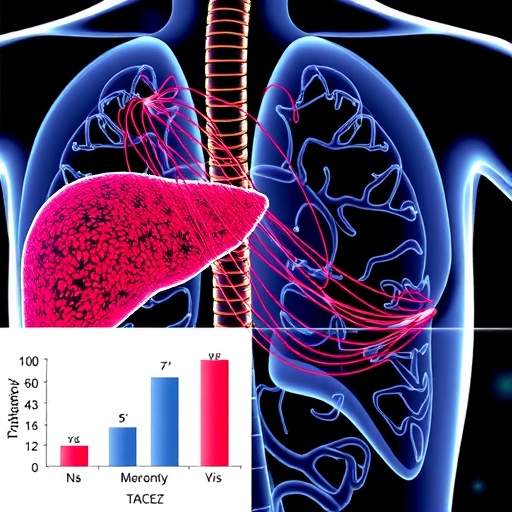
In the relentless battle against hepatocellular carcinoma (HCC), particularly when it recurs after the critical intervention of liver transplantation (LT), new therapeutic strategies emerge as beacons of hope within the oncology community. A groundbreaking retrospective study, recently published in BMC Cancer, sheds light on the efficacious combination of transarterial chemoembolization (TACE) with targeted tyrosine kinase inhibitors (TKIs) — specifically sorafenib or lenvatinib — followed sequentially by regorafenib, marking a significant advancement in managing post-LT recurrent HCC.
HCC recurrence post-liver transplantation remains a daunting clinical challenge. While LT offers a curative potential for primary tumor eradication, the specter of tumor relapse casts a long shadow over long-term patient survival. Standard therapeutic options are often limited by the delicate balance between graft tolerance, immunosuppressive therapy, and tumor control. In this clinical landscape, the integration of locoregional and systemic treatments demands meticulous evaluation to maximize efficacy without compromising patient safety.
TACE, a minimally invasive locoregional therapy, exploits the hypervascular nature of HCC by delivering chemotherapeutic agents directly into the hepatic artery feeding the tumor, followed by embolic material to induce ischemic necrosis. This procedure has demonstrated variable success in controlling intrahepatic lesions. However, monotherapy with TACE often falls short in addressing microscopic satellite lesions and extrahepatic spread, necessitating adjunctive systemic therapies.
.adsslot_41xc6RMGud{width:728px !important;height:90px !important;}
@media(max-width:1199px){ .adsslot_41xc6RMGud{width:468px !important;height:60px !important;}
}
@media(max-width:767px){ .adsslot_41xc6RMGud{width:320px !important;height:50px !important;}
}
ADVERTISEMENT
Tyrosine kinase inhibitors, such as sorafenib and lenvatinib, revolutionized systemic treatment paradigms for advanced HCC by targeting multiple signaling pathways involved in tumor proliferation, angiogenesis, and metastasis. Sorafenib, an oral multikinase inhibitor, suppresses RAF kinase and receptor tyrosine kinases implicated in angiogenesis, while lenvatinib offers broader inhibition including vascular endothelial growth factor receptors (VEGFR) and fibroblast growth factor receptors (FGFR), rendering it potent in halting tumor progression.
The retrospective analysis conducted by Ye et al. encompasses 78 patients who experienced recurrent intrahepatic HCC following liver transplantation. Of these, 70 patients were treated with the innovative strategy combining TACE and either sorafenib or lenvatinib, succeeded by regorafenib administration. Regorafenib, an oral multikinase inhibitor structurally related to sorafenib, further extends antiangiogenic and antiproliferative effects by targeting additional kinases, thus serving as a vital sequential therapy.
Results from this extensive clinical evaluation are promising. The median time to progression (TTP) of intrahepatic recurrent HCC under the combination regimen was documented at six months, reflecting a notable retardation in tumor growth kinetics. Furthermore, median post-recurrence survival (PRS) reached sixteen months, while overall post-transplantation survival (PTS) extended to twenty-five months, indicating substantial survival benefits in this high-risk patient cohort.
Crucially, the objective response rate (ORR) of 71.4% underscores the regimen’s strong antitumor efficacy, with over two-thirds of intrahepatic tumors exhibiting measurable reduction or disease stabilization. This level of response represents a remarkable stride in a population often beset by limited treatment avenues and poor prognoses.
Safety profiles, meticulously assessed throughout the study duration, revealed that adverse events associated with this combined therapeutic approach were manageable. Common toxicities included post-embolization syndrome, characterized by transient fever, pain, and nausea, along with hematologic effects such as myelosuppression. However, these side effects did not necessitate widespread treatment discontinuations, affirming the protocol’s tolerability.
Mechanistically, the synergistic interplay between TACE and TKIs lies at the heart of this treatment success. While TACE effectively induces ischemic tumor necrosis, it paradoxically raises local hypoxia-driven proangiogenic factors, potentially fueling tumor regrowth. TKIs counteract this phenomenon by suppressing angiogenesis, thereby consolidating treatment efficacy and forestalling recurrence.
This study also emphasizes the sequential incorporation of regorafenib following sorafenib or lenvatinib, which may overcome acquired resistance pathways frequently encountered in monotherapy. Regorafenib’s extended kinase inhibition spectrum contributes to sustained disease control, heralding a new frontier in adaptive therapeutic strategies.
Importantly, the research highlights the nuanced balance required in managing immunosuppression to prevent graft rejection without fostering tumor proliferation. The integration of anticancer agents within this delicate immunological milieu demands continued investigation to optimize dosing and scheduling.
Beyond clinical outcomes, this study propels forward the translational understanding of HCC biology post-transplantation, illuminating the molecular crosstalk underpinning recurrence and therapeutic resistance. It sets a precedent for future prospective trials to validate these findings and refine treatment algorithms.
The implications for patient care are profound. Providing effective, tolerable, and prolonged survival options after liver transplantation marks a leap towards improving quality of life and longevity in recurrent HCC patients, who traditionally face grim outlooks.
In conclusion, the retrospective study by Ye et al. underscores the potent prognostic impact of combining TACE with sorafenib or lenvatinib followed by regorafenib, offering a beacon of hope against the formidable clinical hurdle of recurrent hepatocellular carcinoma after liver transplantation. Its findings pave the way for tailored, multimodal approaches that intricately meld locoregional therapies with systemic targeted treatments, laying a robust foundation for next-generation oncologic care paradigms.
As the oncology community continues to grapple with the complexities of HCC recurrence, breakthroughs like this galvanize a spirit of optimism and underline the critical role of methodical clinical research. Future investigations will undoubtedly build upon this groundwork, progressively enhancing therapeutic precision and patient outcomes in one of liver cancer’s most challenging scenarios.
Subject of Research: Therapeutic efficacy and safety of transarterial chemoembolization combined with tyrosine kinase inhibitors (sorafenib or lenvatinib) followed by regorafenib in recurrent hepatocellular carcinoma after liver transplantation.
Article Title: Prognostic impact of tace combined with sorafenib or lenvatinib followed by regorafenib in recurrent hepatocellular carcinoma after liver transplantation: a retrospective study.
Article References:
Ye, Zd., Song, Mc., AMA, AK. et al. Prognostic impact of tace combined with sorafenib or lenvatinib followed by regorafenib in recurrent hepatocellular carcinoma after liver transplantation: a retrospective study.
BMC Cancer 25, 1049 (2025). https://doi.org/10.1186/s12885-025-14446-9
Image Credits: Scienmag.com
DOI: https://doi.org/10.1186/s12885-025-14446-9
Tags: combination therapy for HCC managementhepatocellular carcinoma post-transplant treatmentimmunosuppressive therapy and tumor controlliver transplantation and cancer recurrencelocoregional therapy for hepatocellular carcinomaminimally invasive treatmentspostoperative liver cancer survival strategiesregorafenib in post-transplant liver cancersorafenib and lenvatinib for HCCTACE and targeted therapy for liver cancertargeted tyrosine kinase inhibitors in liver cancertransarterial chemoembolization effectiveness





